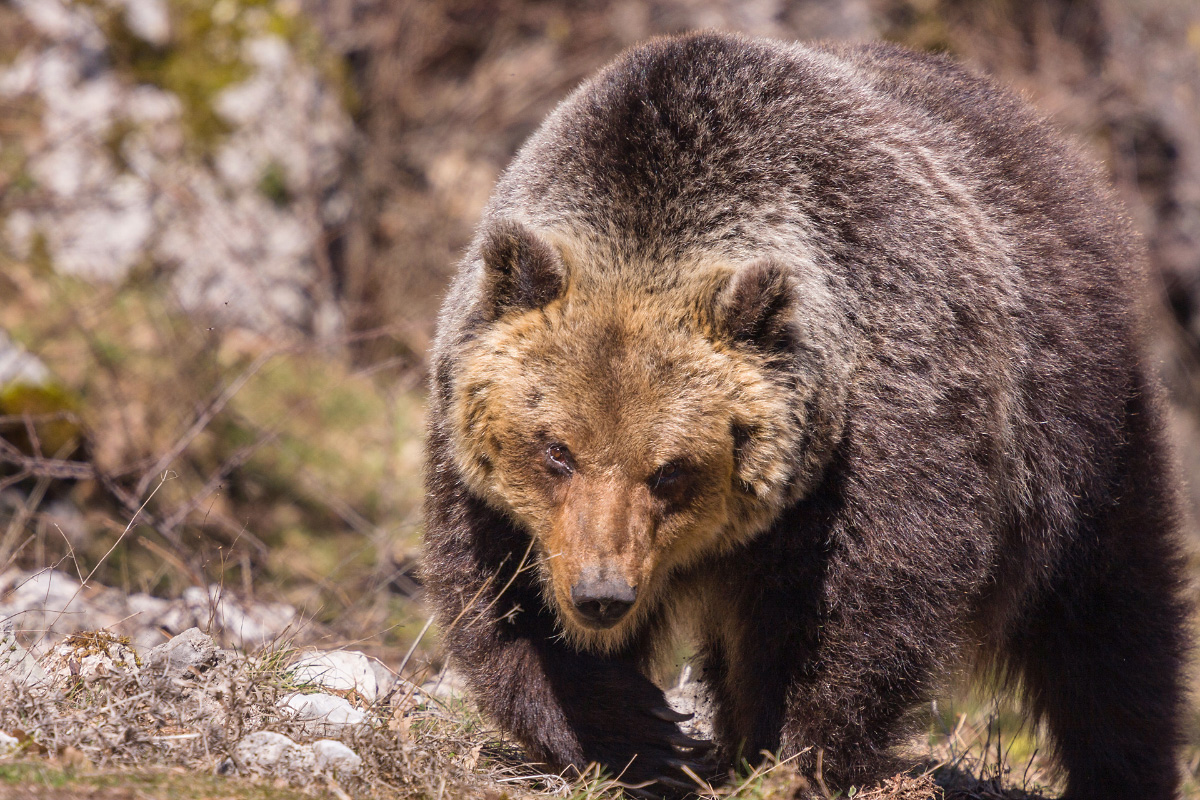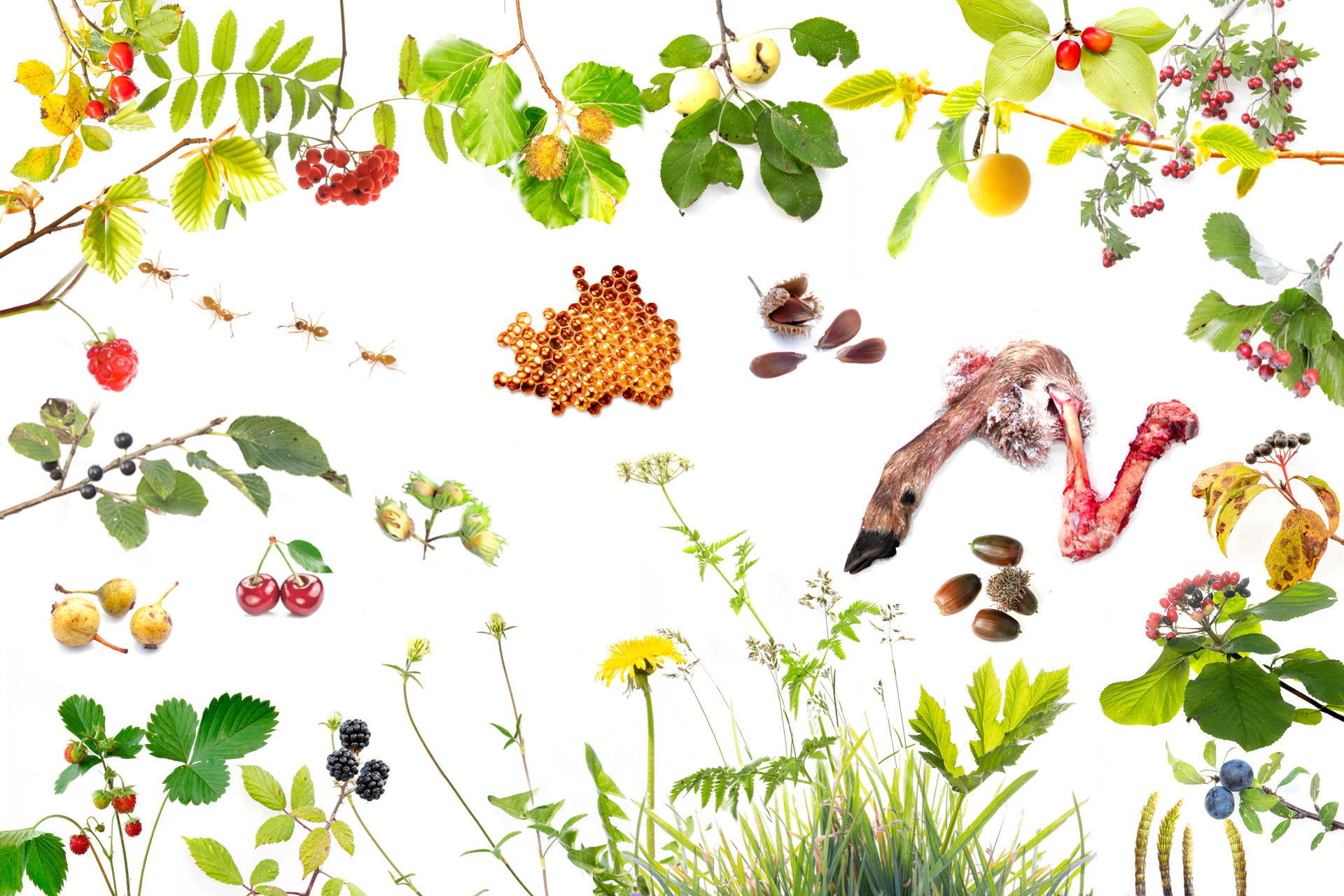A bear’s diet
A bear’s diet
For much of the year, bears work hard to put on weight, but in winter they fast
The diet of bears varies greatly throughout the year, as does their appetite and behaviour.
Bears are physiologically adapted to overeat and to convert any excess calories efficiently into body mass. To survive, bears need eight to nine times more energy than other carnivores. Their only goal is to become obese, with the advantage over us that they can do so while remaining healthy. If we ate like a bear, we would suffer from diabetes, heart problems and high blood pressure. In less than seven to eight months, a bear may put on as much as 30-40 kg of weight. But in nature, nothing happens by chance.
American bear expert David Mattson reveals all the secrets of bear obesity. Can we learn anything from the eating habits of these animals? Don’t overdo the protein for sure, but it’s always better to avoid too much sugar and fat.
Bears spend the winter fasting, so during the rest of the year, their diet is critical to their survival and reproductive success
In the Apennines, bears may spend up to five months in the den, a strategy developed to save energy in a season when food is scarce. Between November and December, both males and females enter a lethargic state known as hibernation, not eating, drinking, defecating or urinating . Their breathing and heart rate slow down and the energy costs of an active life are decreased by more than 70%. In order to survive this fast, bears therefore have nothing but the fat reserves accumulated during the rest of the year to rely on. When a bear wakes up, it may have lost up to 20% of its weight before entering the den. So for a bear, it’s better to put on a few extra kilos before the long sleep. But not all bears can spend the winter “in economy mode”. If a female has mated in the spring, when she enters the den, the embryo starts developing again after a period of “quiescence” known as diapause. This culminates between January and February when she gives birth. While the mother is still “sleeping”, the cubs are awake and active. They must be fed and kept clean and warm. So when she wakes, a mother may have already lost almost 50% of her accumulated fat reserves. To successfully survive this delicate phase, a female therefore needs to focus on gaining as much weight as possible during the year.
Some researchers have shown that implantation of the embryo and subsequent development of the foetus only occur in females that have managed to accumulate 20% to 30% of body fat. Cubs are born weighing less than 500 g, but when they leave the den at three to four months old after being nourished exclusively on milk, they can weigh as much as 5-9 kg. Nursing females therefore need to produce milk with a very high fat (about 18%) and protein (about 6%) content and before winter they need to supplement their diet with abundant protein. This enables their offspring to put on weight rapidly, not only in the den, but also during the first few months after birth when the female will have to think not only of feeding her young, but also herself.

A particularly fat female bear in late autumn. Before entering hibernation, a bear’s weight can increase by up to 30%. (Photograph taken in controlled conditions)
To put on weight, bears follow a diet which is both “fattening” and at the same time healthy and balanced
Although classified as carnivores, bears eat far less protein than this definition suggests. To gain weight, their diet needs to be a well-balanced mix of proteins, fats and carbohydrates. An unbalanced diet, for example, lacking in protein with respect to the other macronutrients, would double the maintenance requirement and make it more difficult to gain weight. When protein is lacking, instead of putting on weight, bears lose it rapidly. On the other hand, the same would happen with a high-protein diet, albeit with much more gradual effects over a longer period of time. Several studies in captivity have shown that if bears are able to select their food each day, they choose a mixed diet, with proteins accounting for about 17% of the assimilated energy and the addition of foods rich in fats, or if not available, carbohydrates. In nature, it’s harder to eat an optimum meal every day, not least because the availability of resources varies with the seasons. So the bears balance their diet over a much longer time scale of months rather than days.
The nutritional needs of bears, and thus their whole life, vary with the seasons, adapting to the availability of food.
They accumulate lean mass mainly in spring and early summer and body fat in midsummer and autumn. This diet coincides with the seasonal availability of food. In the first few months after leaving the den, the bears eat foods richer in proteins than energy (herbaceous plants for example), then when fruits ripen in summer and autumn, they have much higher calorie foods at their disposal, providing fats and carbohydrates to help balance the protein excess in spring. This rule is followed by all species of temperate zone bears, from the more “vegetarian” black bears to the more “carnivorous” species such as the grizzly. Due to their smaller size and therefore lower energy requirements, black bears are also able to maintain their body mass during the spring months, or even to gain weight. Considering that a Marsican bear is on average even smaller than a black bear, an animal in the Apennines can probably put on weight throughout the entire year. But that’s not all. Apennine bears have access to a mixed diet rich in high energy foods throughout the year, undoubtedly making it easier for them to stay fit and healthy.
Bears feeding on beech mast, grass and berries. The diet of bears in the Apennines varies greatly with the seasons.
Bears plan their life around what they can find to eat. This means that during the year, their physiology and behaviour may change many times. The timing of these animals is amazing, but evolution is not to be taken lightly! Bears have, in fact, evolved specifically to enable them to optimise resources, time and energy.
In the early summer months, when calorie-rich foods are scarce, bears invest their energy in reproducing, in other words, mating or raising their offspring. During this period, a high-protein diet is beneficial to both males who have to compete with each other and females who have to nurse their young. In this period of “hypophagia”, bears have less appetite and need less energy. In females, after fertilisation, foetal development stops at a few cells. When the season of plenty comes, the bears can therefore concentrate exclusively on feeding, minimising any further expenditure of energy. Summer, in fact, ushers in the period of “hyperphagia”, when the bears’ appetite increases exponentially, as does their energy requirement. With the arrival of winter when food supplies begin to run out, the bears finally stop feeding and leading an active life. Mothers in particular devote themselves solely to caring for their young.

Overview of an Apennine brown bear’s diet, with many of the food resources available in its natural environment according to the seasons (not to scale).
Bears feed on a wide variety of foods varying in weight, energy content and digestibility and must therefore use all their ingenuity to feed efficiently
Bears have a very simple digestive system, consisting of an oesophagus, stomach and small and large intestines. Unlike herbivores such as deer or horses, they therefore lack a specialised chamber (caecum or rumen) where, thanks to symbiosis with bacteria, complex carbohydrates such as herbaceous plant fibres can be digested. Bears in general, and Marsican bears in particular, have few adaptations for a vegetarian diet. These consist of their dentition and skull structure, allowing them to fragment the plant matter in their diet more efficiently, and specific enzymes to digest plants. A bear’s digestion times are therefore very rapid and sufficient to efficiently assimilate proteins, lipids and simple carbohydrates only. So for a bear, meat is 90% digestible, fruits 60% digestible, and grass just 30% digestible. But on the other hand, herbaceous plants are the most common and rich in proteins, although with a lower calorie content. Insects, particularly ants, contain fewer calories than meat, but are easy prey and very high in protein and rare amino acids. Bears know how to exploit the qualities of each food. For example, in the case of herbaceous plants, the limiting factors are poor digestibility and low nutrient content. The bears therefore go in search of the first shoots, or the most nutritious vegetative parts (buds, leaves and roots) which they eat in large quantities. In the case of berries, the limiting factors are mainly size and weight. So in order to obtain a satisfying mouthful, bears have to seek out the richest bushes, or fruits growing in clusters. In either case, having time to feed is a factor in their favour.
Bears retain plant matter for a shorter time than specialised herbivores such as ruminants and they digest it less. On the other hand, they retain meat for about twice as long as plant matter to better absorb its more digestible nutrients. A single-food diet might be very demanding (as well as dysfunctional) for a bear, given that, for the same number of calories, a fawn a few weeks old corresponds to a meal of millions of ants.
Evolution has shaped bears into adaptable and efficient animals, able to feed up to 14 hours a day if necessary. Any interruption can affect their ability to nourish themselves adequately.

